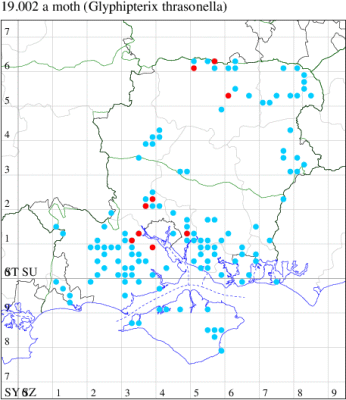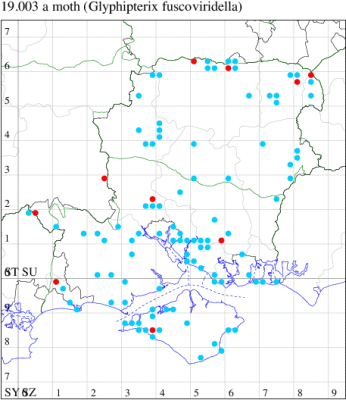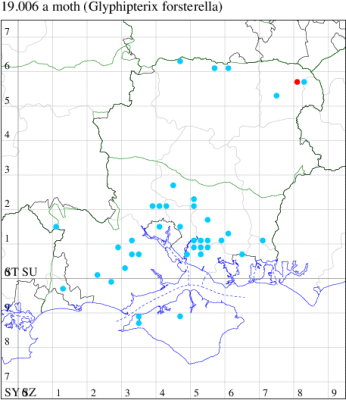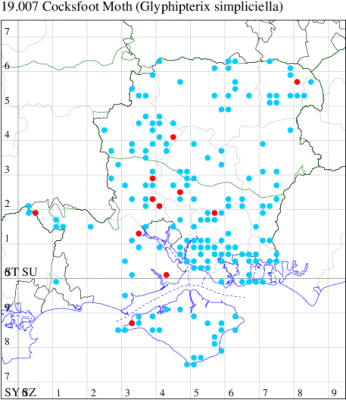2021 Annual Report for: Glyphipterigidae / Glyphipteriginae
For species seen in 2021 that had less than or equal to 100 records, full details are included; for more common species, the earliest, latest and highest count by vice-county are shown. The narrative for each species is taken from the main Hantsmoths website, and it is possible that some information on abundance and occurrence can get out of date, as it is impossible to keep up with all changes; however it should give a good introduction to each species. The tables in each species account summarise the previous status, and that for the current year.
For the maps, all records prior to 2021 are shown by a blue dot (the larger the dot, the more recent), with the current year's records shown in red. As previous records are superimposed on any report for 2021, new sites have greater emphasis (i.e. will show as 'more red').
In the species accounts, an asterisk next to a location indicates a new 10km square record; earliest ever dates are highlighted in orange, and latest ever in red. Initials in the species accounts refer to the recorders listed here. Please get in touch if you identify any omissions or errors, in particular if you have records that have yet to be submitted. Details of how to submit records can be found here.
19.002 [B&F: 0397] Glyphipterix thrasonella (Scopoli, 1763) - Common
Common in a wide range of marginal, aquatic habitats, including bogs, damp heathland and mosses, throughout the British Isles. Widespread and fairly common in Hampshire and on the Isle of Wight. Wingspan 10-15 mm. Generally considered to be day-flying, but often recorded over-night at light traps. The Glyphipterix form a distinctive group, in which the forewing has a characteristic bulge in the costal half of the termen, and appears distinctly folded longitudinally, although G. fuscoviridella is atypical. G. thrasonella has a diagnostic elongate coppery black mark at tonus, which include three silver dots (MBGBI Vol 2). Larva believed to feed within stems of various species of Rush, although the exact foodplant is uncertain.
Records prior to 2021
| Vice County | #Records | #Individuals | First Record | Last Record |
|---|---|---|---|---|
| 10 | 16 | 265 | 1937 | 2020 |
| 11 | 303 | 1157 | 1972 | 2020 |
| 12 | 72 | 1756 | 1974 | 2020 |
2021 records
| Vice County | #Records | #Individuals | Max Quantity |
|---|---|---|---|
| 11 | 8 | 6 | 1 |
| 12 | 3 | 3 | 1 |

Records by year
Records by week (adult)
Records by week (larval)
Record Details
VC11: Marchwood, one, 31 May (CTha); Woodlands, NF, present, 30 Jun (RBW); Totton, one, 11 Jun (LHan); Romsey, one, 30 Jun (MBak); one, 24 Jun; one, 26 Jun (NRJ); Wildern LNR, Hedge End, present, field observation, 02 Jun (DAS); one, field observation, 05 Jun (TCrw);
VC12: Ecchinswell, one, 13 Jun (MJN); Ashford Hill Meadows NNR, one, field observation, 06 Jun (ACB); Basingstoke, one, 14 Jun (MJW)
19.003 [B&F: 0396] Glyphipterix fuscoviridella (Haworth, 1828) - Common
Common in dry grassland throughout much of England, Wales and south-eastern Scotland. In Hampshire and on the Isle of Wight widespread in all three vice-counties. Wingspan 10-16 mm. Day-flying. Quite distinct amongst the Glyphipterix species by reason of its plain brassy forewing and straight termen, the latter distinguishing it from plain forms of G. thrasonella (MBGBI Vol 2). Larva feeds within stems of Field Wood-rush.
Records prior to 2021
| Vice County | #Records | #Individuals | First Record | Last Record |
|---|---|---|---|---|
| 10 | 42 | 160 | 1900 | 2020 |
| 11 | 116 | 447 | 1972 | 2020 |
| 12 | 63 | 678 | 1974 | 2020 |
2021 records
| Vice County | #Records | #Individuals | Max Quantity |
|---|---|---|---|
| 10 | 1 | 1 | 1 |
| 11 | 5 | 8 | 4 |
| 12 | 7 | 219 | 200 |

Records by year
Records by week (adult)
Records by week (larval)
Record Details
VC10: Brook Down, one, field observation, 05 Jun (DCoo);
VC11: Bentley Wood, Eastern Clearing, present, field observation, 10 Jun (PMO); Romsey, three, field observation, 13 Jun; one, 24 Jun (NRJ); Wickham Common, four, 28 May (KCok, RJD, MLO, DWal); Merritown Heath, present, 28 May (DFoo);
VC12: Headley Gravel Pit, two, field observation, 17 May; Ron Ward's Meadow, Tadley, 200, field observation, 08 Jun (GJD); Minley Wood, eight, field observation, 08 Jun; six, field observation, 09 Jun; one, field observation, 13 Jun; Blackwater, one, 28 May; one, field observation, 02 Jun (BDal)
19.006 [B&F: 0394] Glyphipterix forsterella (Fabricius, 1781) - Local
Local in damp grassland and woodland throughout mainland Britain and in two vice-counties of Ireland, apparently becoming more widespread and common. In south Hampshire, now widespread and fairly common, but remaining very rare in the north and on the Isle of Wight. Wingspan 8-11 mm. Separated from several similar species by the clear silver dot in the blackish apical spot (MBGBI Vol 2). Larva feeds within ears of Sedge.
Records prior to 2021
| Vice County | #Records | #Individuals | First Record | Last Record |
|---|---|---|---|---|
| 10 | 5 | 6 | 1900 | 2017 |
| 11 | 89 | 133 | 1972 | 2019 |
| 12 | 11 | 18 | 1974 | 2020 |
2021 records
| Vice County | #Records | #Individuals | Max Quantity |
|---|---|---|---|
| 12 | 3 | 4 | 2 |

Records by year
Records by week (adult)
Records by week (larval)
Record Details
VC12: Minley Wood, one, field observation, 08 Jun; two, field observation, 14 Jun; one, field observation, 22 Jun (BDal)
19.007 [B&F: 0391] Cocksfoot Moth Glyphipterix simpliciella (Stephens, 1834) - Common
Common on grassland throughout the British Isles. Widespread and common in Hampshire and on the Isle of Wight. Wingspan 6-9 mm. Day-flying, and often easily found by searching buttercup flowers on warm, sunny days, when the moths may congregate in large numbers to feed, or by netting over the foodplant. Three other similar species may also be encountered, but they are all scarce: G. schoenicolella, with hindwing dorsal cilia white in basal half; G. equitella, with additional silver dot in disc before apex; and G. forsterella, with silver dot in blackish apical spot (MBGBI Vol 2). Larva feeds within ears of Cock's-foot and Tall Fescue, over-wintering in a cocoon.
Records prior to 2021
| Vice County | #Records | #Individuals | First Record | Last Record |
|---|---|---|---|---|
| 10 | 34 | 56 | 1900 | 2019 |
| 11 | 270 | 724 | 1972 | 2020 |
| 12 | 121 | 1246 | 1974 | 2020 |
2021 records
| Vice County | #Records | #Individuals | Max Quantity |
|---|---|---|---|
| 10 | 2 | 2 | 1 |
| 11 | 9 | 34 | 20 |
| 12 | 4 | 33 | 18 |

Records by year
Records by week (adult)
Records by week (larval)
Record Details
VC10: Totland, one, 29 May; one, 19 Jun (RTer);
VC11: Totton, one, 12 Jun (LHan); Romsey, one, field observation, 13 Jun (NRJ); Kings Somborne, one, 09 Jun (GCE); Exbury Gardens, present, field observation, 25 Jun (PBar); Barn Piece, Eastleigh, one, 12 Jun (KArb); Twyford, five, swept, 5+ swept from nettles, 07 Jun; 20, swept, 07 Jun; four, swept, swept from nettles, 07 Jun (RJD); Bishop's Waltham, one, field observation, 19 May (DTru);
VC12: Bullington, one, 10 Jun (GCE); Minley Wood, 12, field observation, 08 Jun; 18, field observation, 09 Jun; two, field observation, 10 Jun (BDal)